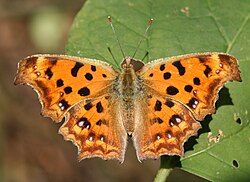Bob
Have a question related to this hub?
Alice
Got something to say related to this hub?
Share it here.
| Asian comma | |
|---|---|

| |
| Scientific classification | |
| Kingdom: | Animalia |
| Phylum: | Arthropoda |
| Class: | Insecta |
| Order: | Lepidoptera |
| Family: | Nymphalidae |
| Genus: | Polygonia |
| Species: | P. c-aureum
|
| Binomial name | |
| Polygonia c-aureum | |
| Synonyms | |
|
Nymphalis c-aureum | |
Polygonia c-aureum, the Asian comma, is a middle-size butterfly found in Japan (from Hokkaidō to Tanegashima), Korean Peninsula, China, Taiwan, and Indochina.
It has a wingspan of 27 mm. Wings are orange with black dots. The undersides of the wings is mottled brown (tree bark like) with a shiny comma mark on the center of the hindwing. The main difference with other comma species is that it has blueish markings on the bottom of its hindwing.
P. c-aureum is common in suburban areas. It is not a threatened species. The larvae of the species feed on plants such as: Humulus japonicus, the Japanese hop.